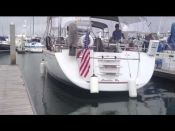
Sailing Her in – 12 Tips to Make It Easier
If you sail for long enough, at some point you will have an engine failure. Instead of calling for help, a bit of preparation and – dare I say it – practice, might save the day and let you sail in. I learned the hard way, by sailing an engine-free yacht along the Queensland coast for ten years, in all weather and all seasons. It took a while before I became confident, but these are my top 12 tips:
- Choose a sail configuration that lets you manoeuvre comfortably and at a sensible speed. On most boats this means partially furling the headsail and maybe putting a reef in the main, but do ensure you have enough sail area to maintain steerage. You need to keep moving in the lulls, but not be overpowered in the gusts.
- Keep the sheets tangle free and ready to run so you can tack reliably.
- Communication is key. Explain your plan so everyone knows what is expected of them. Don’t shout. Keep everyone in the cockpit where they can hear. Except for when you are dropping sails or anchoring there is no need for anyone to go forward.
- To bear off quickly, dump the mainsheet and keep the headsail sheeted in.
- Near shore and under headlands the wind will be fluky. Keep to the centre of the waterway for the most consistent breeze.
- Always maintain steerageway, even if this means bearing away from the desired course. Losing control of the boat is deadly.
- Try to pass down-tide of obstructions like moored boats. This way, if you lose the wind, you will not end up catching someone’s anchor line, or worse.
- Going behind other boats means being aware of unseen dinghies, fishing lines etc that may be trailing astern of them.
- Always be prepared to stop. Have the headsail ready to furl, main halyard flaked down. When you arrive at your anchoring spot, douse the headsail, and round up into the wind until the boat loses way. Let the mainsheet go. Let go the anchor, with plenty of scope to ensure it holds. Make sure the mainsheet is free so the main doesn’t fill as you drop back.
- In light air, back the mainsail for sternway to dig the anchor in. Push the boom out to one side while holding the helm in the centre.
- If you are coming alongside, do so on the downwind side. In a marina, ask for an outside berth. When the only option is to berth from upwind, douse all sail to avoid lassoing the dock or having the mainsail fill unexpectedly when the boom catches on a pile. Coming alongside from a windward position is option Z unless the wind is extremely light.
- The escape clause! If you get it wrong, sail out and try again. Don’t let a tricky situation escalate into a disaster by being too proud to have another go.
Depending on situation and weather there are endless variations on sailing in. You might need to wait for better weather, or a favourable tide. Sometimes it is downright dangerous to sail all the way in, but you may be able to sail to the entrance of a marina or port and arrange a tow in. Do be aware that accepting a tow is risky unless you trust the skill of the towing crew. VMRs or professional rescue services are the safest options. An alternative is to sail to sheltered water and use the dinghy to tow its mother ship. This is not as straightforward as it sounds, but that is a story for another day…